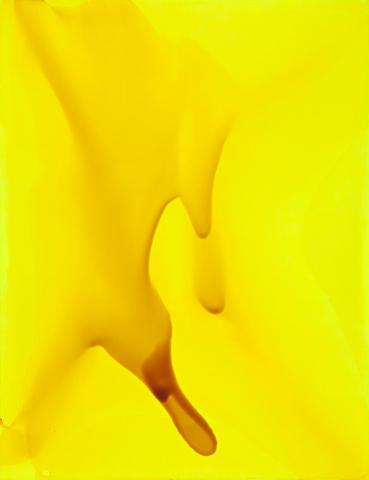STEPHEN DORFF, 2000
DALE FRANK
varnish and synthetic polymer paint on canvas
260.5 x 200.0 cm
Anna Schwartz Gallery, Melbourne
Private collection, Melbourne
Presenting a tactile, ultra-reflective and immersive surface in which to view oneself, Dale Frank’s monochrome paintings are more than just seductive pictures. By implicating the viewer into the artwork, Frank transcends the physical limits of the traditional canvas and allows his artworks to exist in an infinite array of visual possibilities.
The artist’s monochrome, painterly artworks of the early 2000s, of which Stephen Dorff, 2000 is a prime example, explore the materiality of painting with unfettered stylistic freedom. They display the artist’s gestural delight in the viscosity of his varnish paint, applied with all-over approach reminiscent of early 20th century European avant-garde, New York Abstract Expressionism and Colour Field painting. Frank’s paintings of this period do not portray a visual reality, instead they draw attention to the very act and process of painting, the means and materials through which contemporary painters interact with the world. Limiting possible interpretations of intention and meaning, Frank encourages a visceral and tactile appreciation of the painted surface, appealing to the almost erotic attraction to its glossy, wet surface.
The invitingly warm Stephen Dorff and other paintings from this series were created by a careful orchestration of paint poured onto the canvas. Critic Christopher Chapman, writing in the 2008 monograph So Far: The Art of Dale Frank 2005-1980, described Frank’s act of painting as a conceptual one, intricately associated with time-based performance art.1 Due to its thickness and density, Frank’s paint continued to ooze and solidify long after the artist had ceased to intervene. Leaving behind the convoluted narrative titles of the his earlier works, Frank’s paintings of the early 2000s bear remarkably succinct titles, primarily names of young male celebrities: Aaron Eckhardt, Balthazar Getty, Jake Gyllenhaal and Josh Hartnett. For the artist, these were ‘actors who achieved a coolness or sexual allure, or young actors who achieved star status in a brief period then disappeared, transforming the paintings into a type of psychological portrait’.2 The American actor Stephen Dorff had released in 1998 an action-packed blockbuster film, Blade, and the year this painting was created starred in the cult black comedy Cecil B. Demented loosely adapted from the story of Patty Hearst’s 1974 kidnapping. For the artist, the fleeting nature of fame for these young men became an apt metaphor for the transient nature of his own artistic practice, shaped by physical gesture enacted by the artist and by the viewer.
So far, Dale Frank has had a long and diverse career, from a precocious debut in 1975 to a major retrospective show in 2000 at the Museum of Contemporary Art, Sydney, Ecstasy: twenty years of painting. Frank is a singular and anarchic force in the arena of Australian painting. Informed by his unique interaction with the medium itself, Frank dexterously pushes the physical boundaries of painting, eloquently engaging with its theory, bearing all the while little regard for passing fashions.
1. Chapman, C., ‘Dale Frank: Performance Into Painting’, So Far: The Art of Dale Frank 2005 – 1980, Schwartz City, Melbourne, 2008, p. 338
2. Frank, D., email exchange with Chapman, C., quoted in ‘Dale Frank: Performance Into Painting’, So Far: The Art of Dale Frank 2005 – 1980, Schwartz City, Melbourne, 2008, p. 340
LUCIE REEVES-SMITH
